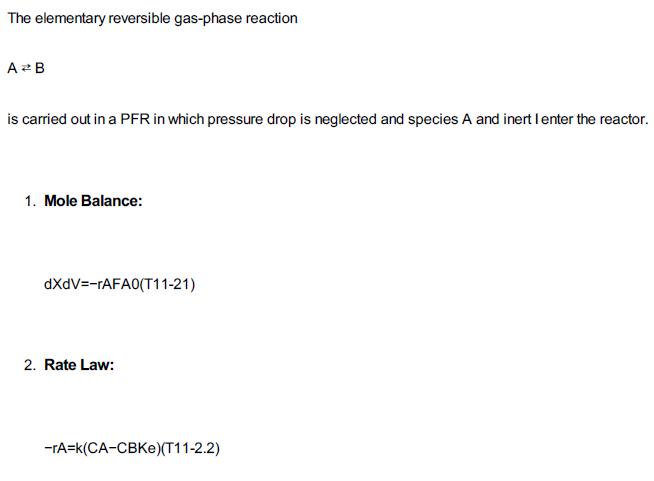Download the following programs from the CRE Web site where appropriate: a. Example Table 11.2: Algorithm for
Question:
Download the following programs from the CRE Web site where appropriate:
a. Example Table 11.2: Algorithm for Gas-Phase Reaction
Wolfram and Python
1. What happens to X and Xe profiles as you vary T0? Can you explain this trend?
2. Use the base case for all of the variables. Which slider variable—Ke2, k1, or T0—has the greatest effect on the temperature profiles? Which slider variable —EA, FA0, or —has the greatest effect on X and Xe?
3. Describe how the reaction rate profile changes as you vary T0?
4. Write three conclusions on what you found in experiments (i)–(iii).
Table 11.2

 and for the case ACp = 0 Ke=Ke2(T2)exp! [AHRx R(1T2-1T)](T11-2.4) 3.](https://s3.amazonaws.com/si.question.images/images/question_images/1697/5/1/8/659652e1443e222e1697518658619.jpg)
![]()
At equilibrium –rA ≡ 0, and we can solve Equation (T11-2.7) for the equilibrium conversion, Xe Xe=Ke1+Ke(T11-2.8)
b. Example 11-3: Adiabatic Isomerization of Balance
Wolfram and Python
1. Describe how both X and Xe profiles change for each of the parameter values, T0, KC, and CA0.
2. What is the minimum feed temperature that would give that maximum possible conversion at the end of the reactor?
3. Vary and ΔHRx∘ describe how the change in the temperature profile changes.
4. What parameter value—CA0, T0, or yA0—affects the reaction rate profile, -rA, the most, and in which ways does it change?
5. Write three conclusions on what you found in experiments (i)–(iv) Polymath
6. What if the butane reaction were carried out in a 0.8-m3 PFR that can be pressurized to very high pressures? What would be the conversion?
7. What inlet temperature would you recommend?
8. Is there an optimum inlet temperature?
9. Plot the heat that must be removed along the reactor (Q˙ vs. V) to maintain isothermal operation.
c. Example 11-4: Calculating the Adiabatic Equilibrium Temperature and Conversion
Wolfram and Python
1. Go to the extremes of the ranges of the sliders and describe how the adiabatic equilibrium conversion changes with each of the variables, T, (–ΔHRx∘), Ke, and ΘI.
2. What inlet temperatures, T0, will give the highest and lowest values of the adiabatic equation temperature?
3. Write a set of three conclusions from your experiments (i) and (ii).
Example 11-4
For the elementary liquid-phase reaction A ⇄ B we want to make a plot of equilibrium conversion as a function of temperature. The reacting species in this industrially important reaction to Jofostan’s economy have been coded with the letters A and B for reasons of National Security and for the company’s proprietary reasons.
1. Combine the rate law and stoichiometry to write –rA as a function of k, CA0, X, and Xe.
2. Determine the adiabatic equilibrium temperature and conversion when species A and inert I are fed to the reactor at a temperature of 480 K.
3. What is the CSTR volume necessary to achieve 90% of the adiabatic equilibrium conversion for CA0 = 1.0 mol/dm3 and υ =0 = 5 dm3/min?
Additional information:
d. Example 11-5: Interstage Cooling for Highly Exothermic Reactions.
(1) Determine the molar flow rate of cooling water (CPw = 18 cal/mol·K) necessary to remove 220 kcal/s from the first exchanger as shown in Figure P11-1A (e). The cooling water enters at 270 K and leaves at 400 K.
(2) Determine the necessary heat-transfer area A (m2) for an overall heat transfer coefficient, U, of 100 cal/s·m2·K. You must use the log-mean driving force in calculating Q˙.![Q=UA[(Th2-TC2)-(Th1-Tc1)]1n(Th2-Tc2Th1-Tc1)(E11-5.7) The 460 K- h2 T 400 K- Heat Exchanger Thi 350 K Reaction](https://s3.amazonaws.com/si.question.images/images/question_images/1697/5/2/0/357652e1ae5f36851697520356874.jpg)
The figure shows a counter-current heat exchanger where the reaction mixture flows from left to right and the coolant flows from right to left. The entry (T subscript h2) and exit (T subscript h1) temperatures of the reaction mixture feed are 460 Kelvin and 350 Kelvin respectively. The entry (T subscript c1) and exit (T subscript c2) temperatures of the coolant stream are 270 Kelvin and 400 Kelvin respectively.
Example 11-5
What conversion could be achieved in Example 11-4 if two interstage coolers that had the capacity to cool the exit stream to 480 K were available? Next, determine the heat duty of each exchanger for a molar feed rate of A of 40 mol/s. Assume that 95% of the equilibrium conversion is achieved in each reactor. The feed temperature to the first reactor is 480 K.
e. Example 11-6: Optimum Feed Temperature
Wolfram and Python
1. Describe what happens to X and Xe as you increase ΘI from 0.3 to 4.
2. Vary ΔHRxand describe what you find.
3. Investigate the parameters Ke, k, and ΘI by setting each to their base case values and then vary T0 and describe what you find.
4. Set Ke2 at its maximum value, 150,000, and then vary T0. What differences do you observe from the base case?
5. Next set ΘI at 3, and again vary the other parameters. Write a sentence or two saying how each variable affects the optimum feed temperature.
6. Explain how inert, ΘI, affects the equilibrium conversion and actual conversion.
7. Write two conclusions about what you found in your experiments (i) through (vi).
Example 11-6
We are going to continue the reaction we have been discussing in Examples 11-4 and 11-5. A ⇄ B To illustrate the concept of an optimum inlet temperature, we are going to plot the conversion profiles for different inlet temperatures for this isomerization, cf. Figures
E11-6.2 and E11-6.3. We will use all the same parameter values and conditions we used in Examples 11-4 and 11-5 and only vary the entering temperature. We start by applying Equations (T11-2.1)–(T11-2.8) to a liquid system so where there is no temperature dependence in the concentration term, that is, CA = CA0 (1 – X). Starting with the mole balance
Step by Step Answer:






